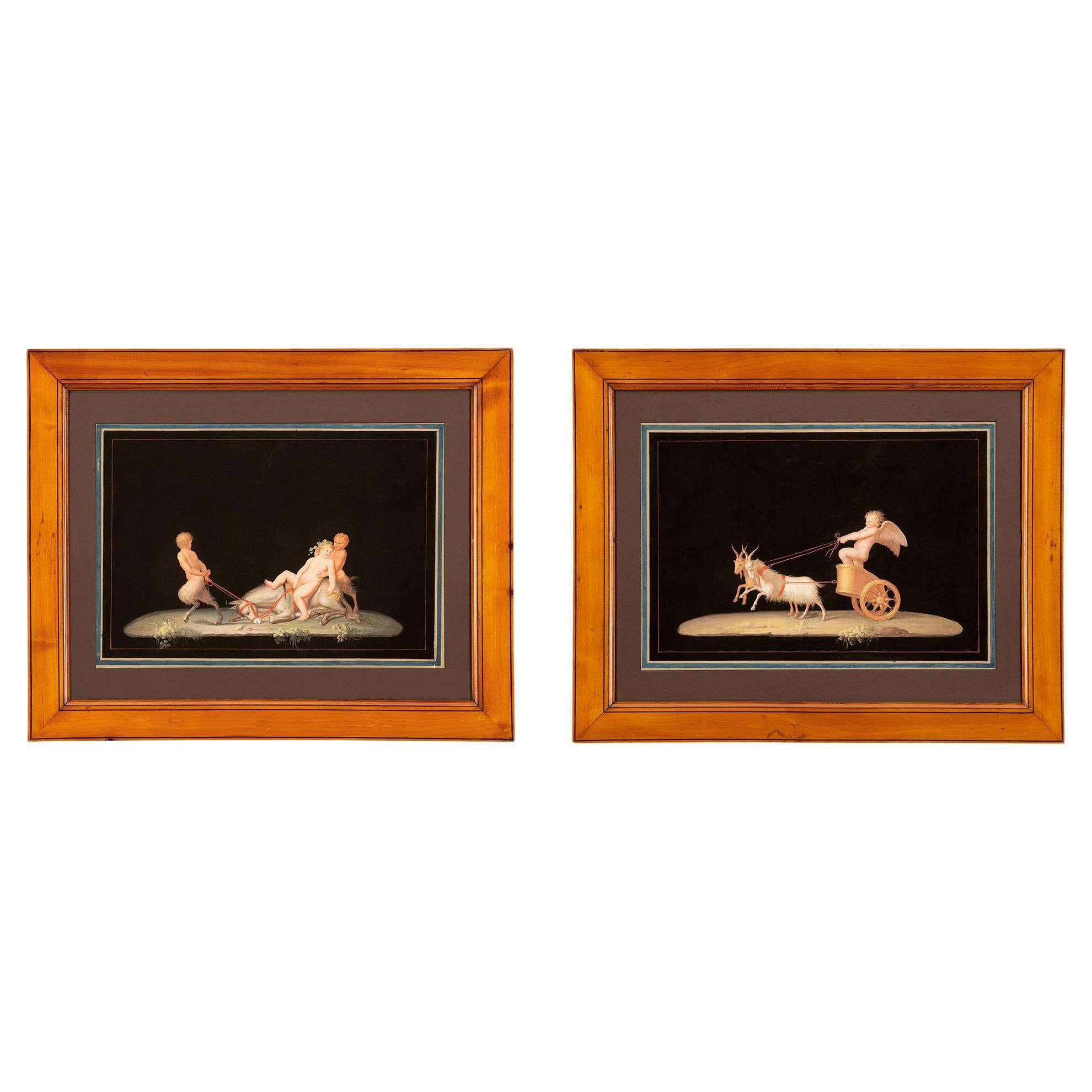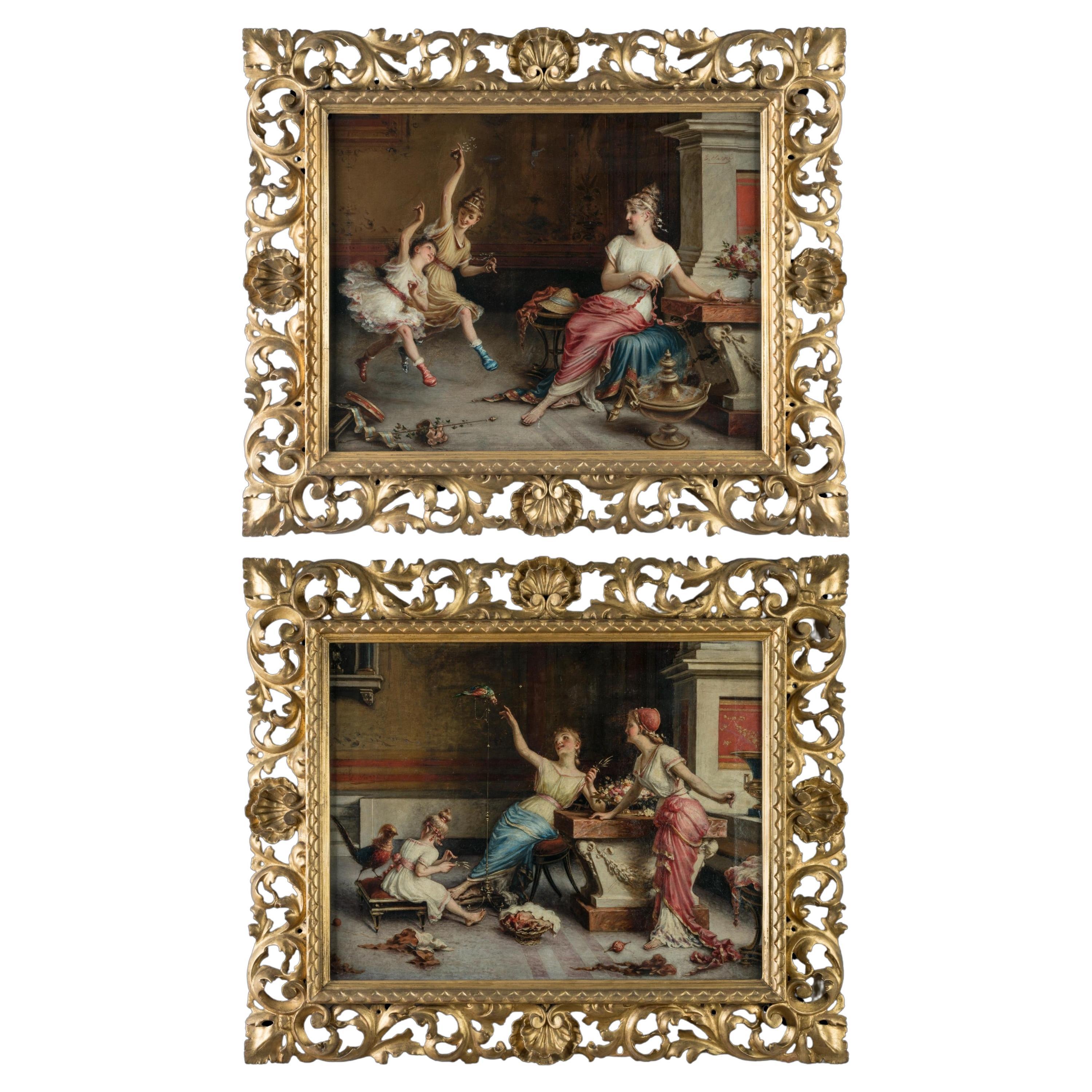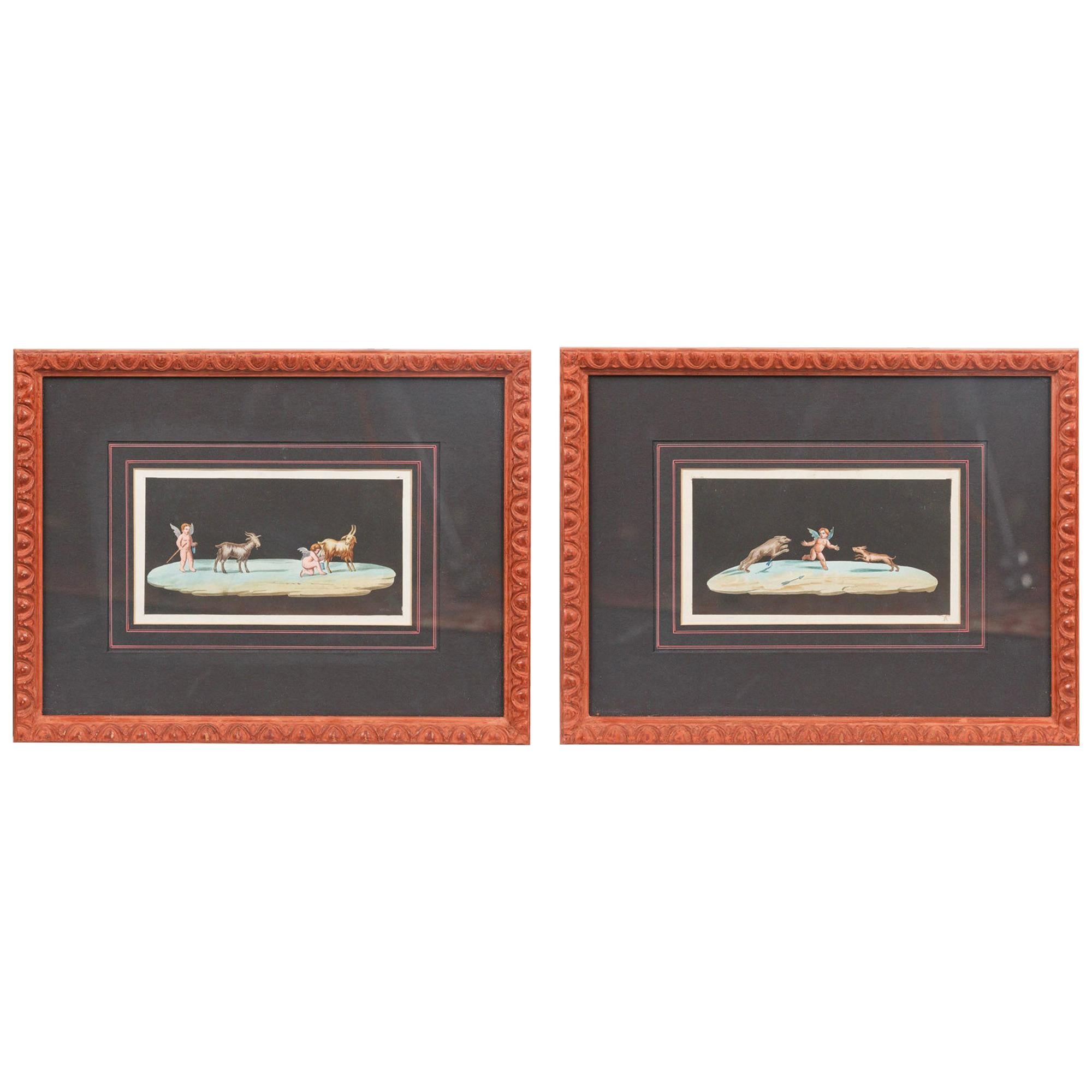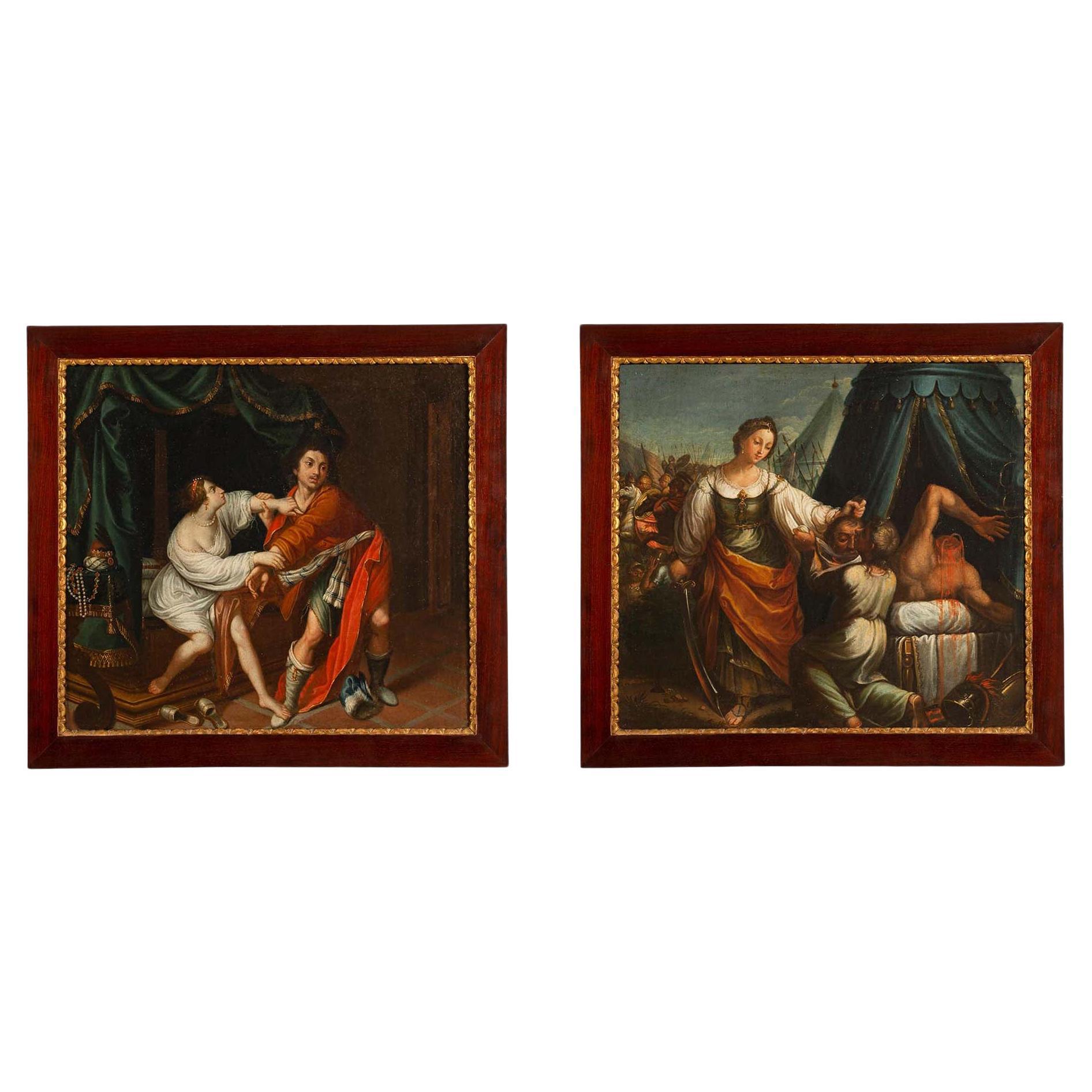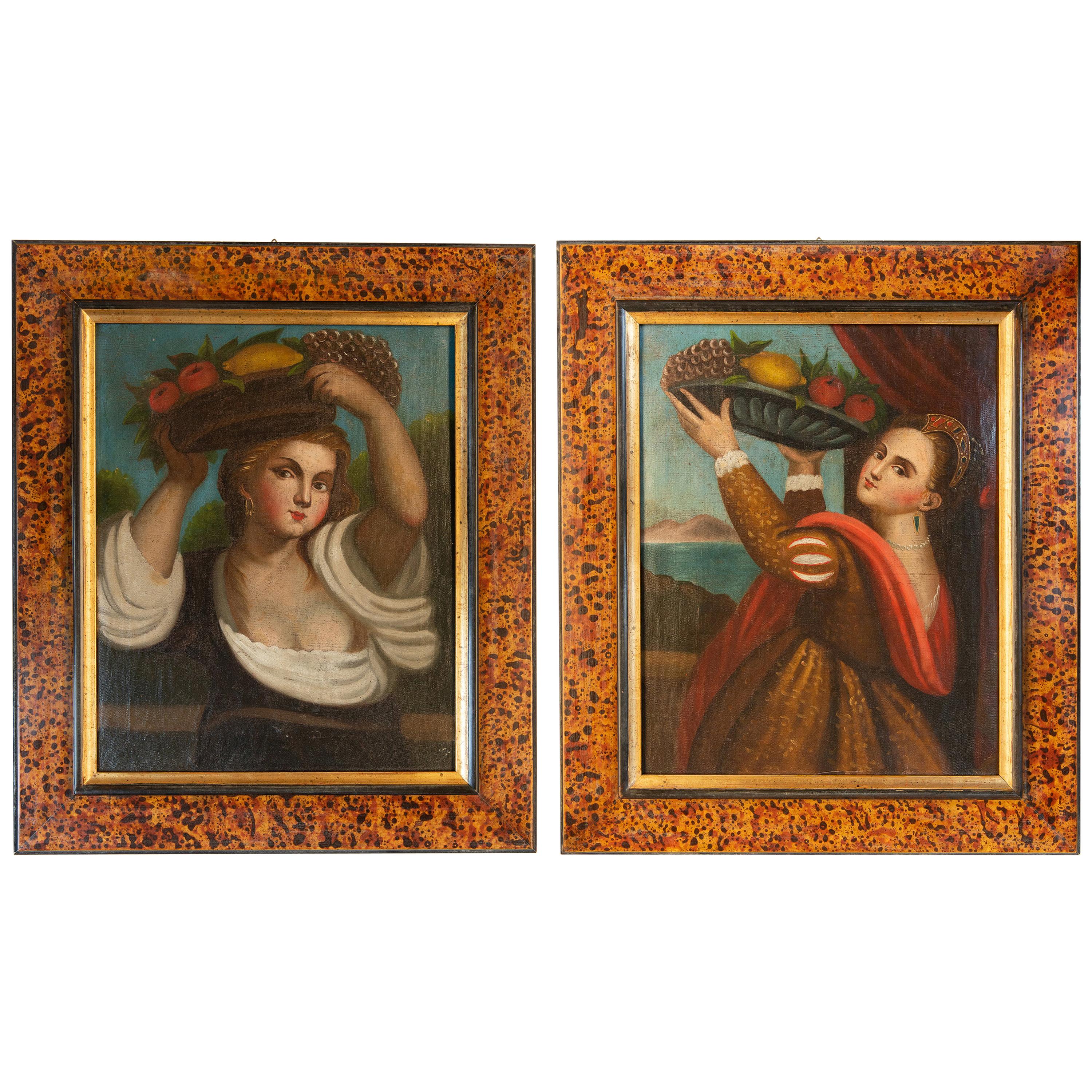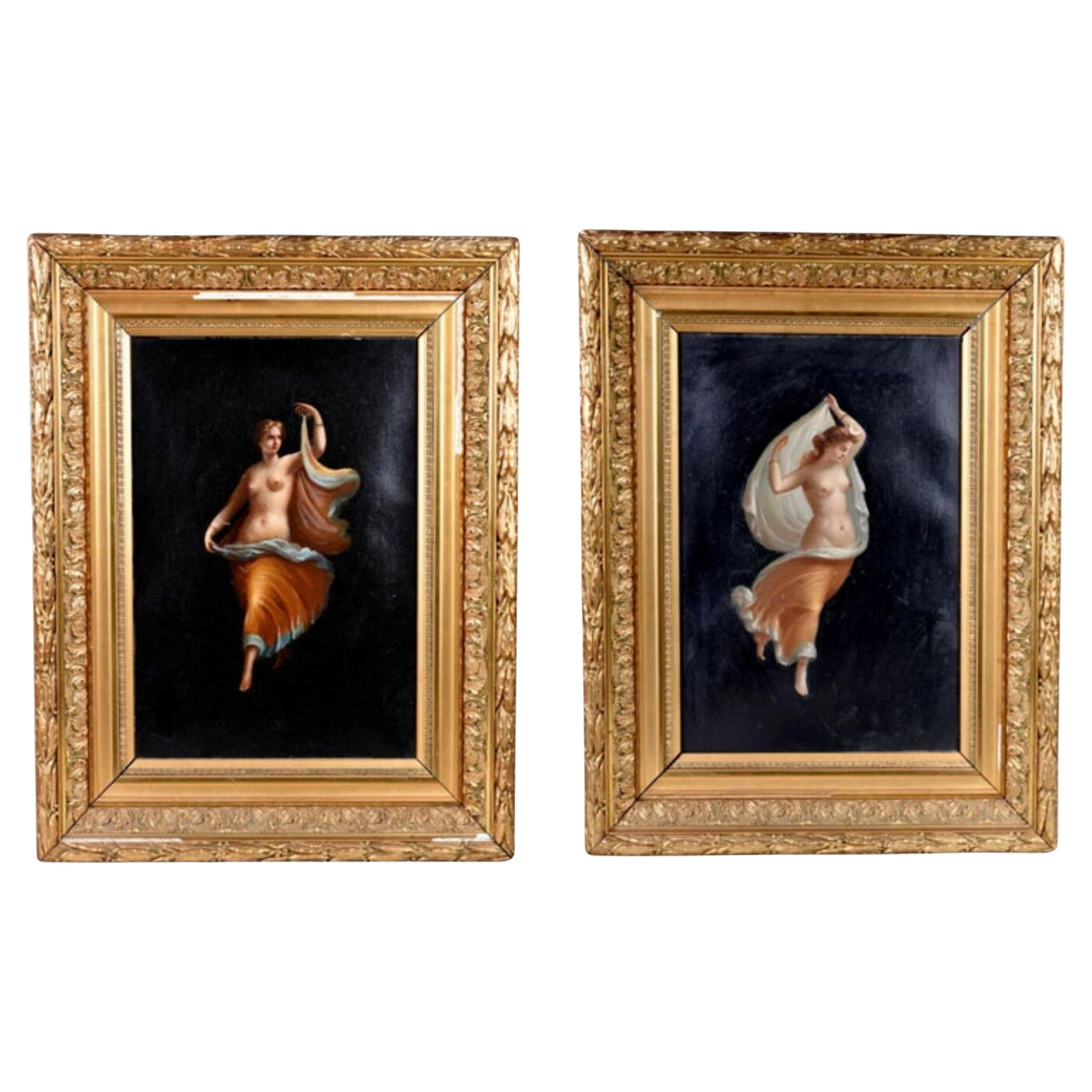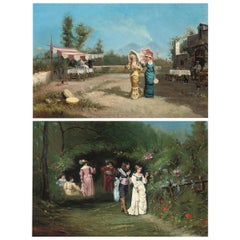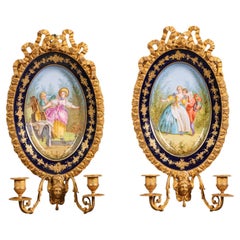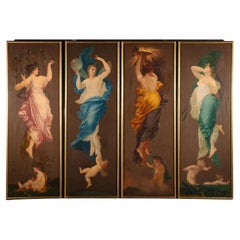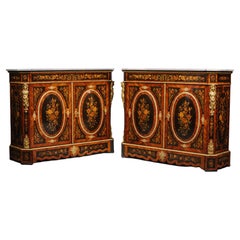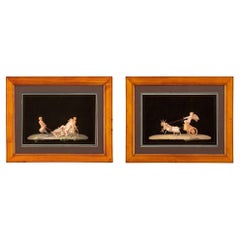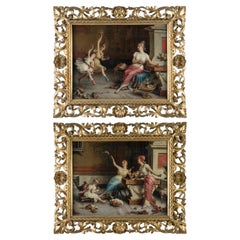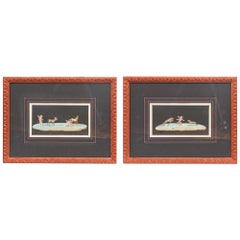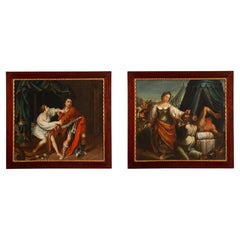Items Similar to A Pair Of ‘Sorrento’ Stained Olive and Fruit Wood Pictures By Michele Grandville
Want more images or videos?
Request additional images or videos from the seller
1 of 6
A Pair Of ‘Sorrento’ Stained Olive and Fruit Wood Pictures By Michele Grandville
$43,605.76
£32,000
€37,715.23
CA$60,013.95
A$66,891.80
CHF 35,095.83
MX$816,857.94
NOK 444,389.55
SEK 420,015.72
DKK 281,485.20
About the Item
A Pair Of ‘Sorrento’ Stained Olive and Fruit Wood Pictures By Michele Grandville (Italian, 1821-1893).
Depicting ‘Roman Tarantella Dancers’ and ‘A Pompeian Harp Recital’, each with a Renaissance style foliate scrolled frame of marquetry penwork, tinted woods and geometric straw mosaic.
The ‘Tarantella Dancers’ signed ‘M Grandville’.
Italy, Circa 1860.
Marquetry production in the Sorrento region of Naples, Southern Italy, has been ongoing since the high Middle Ages. Production from Sorrento can be distinguished from other marquetry centres, such as Tuscany, by the use of olive wood which is abundant in the region.
In 1848 Michele Grandville, a Frenchman, established a workshop with Luigi Gargiulo, from Rome, making fine wood and straw marquetry boxes, furniture and pictures. By 1862 Grandville is recorded to have a shop in Sorrento ‘near the Tasso hotel’ (A Handbook for Travellers in Southern Italy, London, 1862, p. 259). At the 1862 International Exhibition in London ‘Beautiful marquetry and Sorrentowork is exhibited by Michele Grandville, of Sorrento’ is recorded (The Technologist, London, 1862, p. 270).
Michele Grandville appears to have specialised in pictorial decoration as opposed to furniture construction. He was known to have perfected painting in a marquetry mosaic on olive wood in two or more colours, reproducing scenes of daily Neapolitan life, drawn from contemporary engravings of Gaetano Dura, and Pompeian subjects (Nuova Antologia di Lettere, Scienze ed Arti, Volume CXLVII, July-August 1910, Rome, p. 412).
- Dimensions:Height: 25.2 in (64 cm)Width: 30.71 in (78 cm)Depth: 1.97 in (5 cm)
- Materials and Techniques:
- Place of Origin:
- Period:
- Date of Manufacture:Circa 1860
- Condition:Wear consistent with age and use.
- Seller Location:Brighton, GB
- Reference Number:Seller: B782121stDibs: LU1028044240842
About the Seller
5.0
Recognized Seller
These prestigious sellers are industry leaders and represent the highest echelon for item quality and design.
Established in 1964
1stDibs seller since 2014
58 sales on 1stDibs
Typical response time: 3 hours
Associations
The British Antique Dealers' AssociationLAPADA - The Association of Arts & Antiques Dealers
- ShippingRetrieving quote...Shipping from: Brighton, United Kingdom
- Return Policy
Authenticity Guarantee
In the unlikely event there’s an issue with an item’s authenticity, contact us within 1 year for a full refund. DetailsMoney-Back Guarantee
If your item is not as described, is damaged in transit, or does not arrive, contact us within 7 days for a full refund. Details24-Hour Cancellation
You have a 24-hour grace period in which to reconsider your purchase, with no questions asked.Vetted Professional Sellers
Our world-class sellers must adhere to strict standards for service and quality, maintaining the integrity of our listings.Price-Match Guarantee
If you find that a seller listed the same item for a lower price elsewhere, we’ll match it.Trusted Global Delivery
Our best-in-class carrier network provides specialized shipping options worldwide, including custom delivery.More From This Seller
View AllPair of Paintings by Francesco Peluso
By Francesco Peluso
Located in Brighton, West Sussex
A pair of paintings by Francesco Peluso (1836-1916): 'Neapolitan Promenade’ and ‘Pastoral Promenade’.
Oil on canvas.
Signed 'F Peluso' to the ...
Category
Antique 19th Century Italian Paintings
Materials
Canvas, Giltwood
$7,494 / set
Pair of Sèvres Style Oval Porcelain Dishes Mounted as Appliques
By Manufacture Nationale de Sèvres
Located in Brighton, West Sussex
A Pair of Sèvres Style Oval Porcelain Dishes Mounted as Appliques.
The reverse with spurious Chateau des Tuileries marks and S.37 stamp in blue Sèvres 1844'.
Each oval porcel...
Category
Early 20th Century French Wall Lights and Sconces
Materials
Porcelain
'Les Quatre Eléments' by Pierre Victor Galland
Located in Brighton, West Sussex
Pierre-Victor GALLAND (1822-1892)
‘Les Quatre Eléments’
Four, oil on canvas.
France, Circa 1873.
Each painting depicting one of the cardinal elements personified as a female figure in the presence of its most evident attribute. Painted with strong light and colour.
Earth panel depicts one of the four elements in a compelling fashion with an ascendent female figure robed in flowing drapery with foot and arm extended reaching skyward: each with attendant putti below.
Earth is shown swathed in robes of greens and white, with a fanciful foliate headdress of lush leaves and bullrushes.
Air leaps effortlessly into the sky draped in blush pink and holding a slender fruiting bough.
Fire ascends dramatically into the sky holding forth a flaming torch and draped in bright burnished orange and grey, her image seemingly lit from a fire kindled below by an ignipotent putto.
Water suitably draped in billowing azure blue with a translucent undergarment, holds aloft a bubble representing water is portrayed with shimmering translucent wings, an attendant winged putto pulling at her hem.
Under the Second Empire, Haussmann’s transformation of Paris went hand in hand with the construction of luxurious mansions for the new haute bourgeois. Gallards extensive work for wealthy patrons such as Lionel de Rothschild and Edouard André, led him to become one of Paris’s most admired and sought-after decorative artists. His fame quickly spread and led him to carry out projects outside the capital for, among others, Baron von Derwies in Nice, Prince Narischkine in Saint Petersburg and William Vanderbilt in the United States.
Literature
Pierre-Victor Galland, Un Tiepolo français au XIXe siècle. Published in 2006, Somogy, Piscine-musée d'art et d'industrie André Diligent, Musée départemental de l'Oise (Paris, Roubaix, Beauvais). ISBN 978-2-7572-0027-8. (in French)
Materials
Oil on Canvas
Provenance
Acquired in France with four other panels (The Four Seasons), at the end of the 19th century by Herman Ossian Armour (1837-1901), businessman, and founder of the Armour Meat Company and American humanist. He brought them back to his USA residence at Fifth Avenue, New York
Bequeathed to Mary Armour...
Category
Antique 19th Century French Neoclassical Paintings
Materials
Canvas
Pair of Napoleon III Ormolu-Mounted Marquetry Side Cabinets
Located in Brighton, West Sussex
A Pair of Napoleon III Ormolu-Mounted Marquetry side cabinets.
Each cabinet having an eared rectangular marble top above a frieze and doors finely inlaid with elaborate foliate ma...
Category
Antique 19th Century French Napoleon III Sideboards
Materials
Ormolu
Pair of Louis XV Style Porcelain Jardinières, Circa 1840
Located in Brighton, West Sussex
This unusual pair of Sèvres-Style jardinières are each of square section inset with finely painted porcelain panels, depicting floral sprays and genre scenes in the manner of Boucher...
Category
Antique 19th Century English Louis XV Planters, Cachepots and Jardinières
Materials
Ormolu
Pair of Venetian Rococo Carved Giltwood Mirrors
Located in Brighton, West Sussex
A Pair of Venetian Rococo Carved Giltwood Mirrors.
These mirrors have elaborate pierced strapwork crestings surmounted by a shell-shaped corona above a cartouche-shaped plate, the...
Category
Antique 18th Century Italian Rococo Wall Mirrors
Materials
Giltwood
You May Also Like
Pair of Italian 19th Century Gouaches, in the Manner of Michelangelo Maestri
By Michelangelo Maestri
Located in West Palm Beach, FL
A wonderfully decorative and colorful pair of Italian 19th century gouaches, in the manner of Michelangelo Maestri. The pair are of playful satyrs...
Category
Antique 19th Century Italian Paintings
Materials
Canvas, Wood
A Pair of Oil on Canvas "Pompeian" Interior Scenes by Egisto Sarri of Florence
Located in London, GB
A Pair of "Pompeian" Interior Scenes
By Egisto Sarri of Florence
Executed in oil on canvas, and housed in matching hand-carved giltwood frames, depicting intimate domestic life of t...
Category
Antique 19th Century Italian Paintings
Materials
Canvas, Giltwood, Paint
19th Century Neapolitan Pair of Paintings on Paper, in the School of Michaelange
Located in Dublin 8, IE
19th century Neapolitan pair of paintings on paper, in the school of Michaelangelo Meucci (Italian, 1840-1909), depicting winged putti milking a herd of goats and warding off wolves.
Category
Antique 19th Century Italian Neoclassical Paintings
Materials
Paper
Pair of French 18th Century Oil on Canvas in Mahogany and Giltwood Frames
Located in West Palm Beach, FL
A striking pair of French 18th century oil on canvas in mahogany and giltwood frames. Each painting retains its original beautiful mahogany frame with a finely carved charming foliat...
Category
Antique 18th Century French Paintings
Materials
Canvas, Mahogany, Giltwood
Pair of Old Paintings Reproducing "Lavinia from Tiziano"
Located in Alessandria, Piemonte
O/7418 - Interesting pair of old paintings reproducing the very famous works by Tiziano Vecellio : his daughter in the guise of a noblewoman and of a...
Category
Antique Early 19th Century French Beaux Arts Paintings
Materials
Textile
Important Pair of Italian School Paintings "Night and Day" 19th Century
Located in Madrid, ES
Important Pair of Italian School Paintings "Night and Day" 19th Century
Inspired by the excavations of Pompeya
Two oils on the carton.
35cm x 24cm
A year ago it was clean underneath
Category
Antique 19th Century Italian Baroque Paintings
Materials
Paint
More Ways To Browse
Pompeian Style
Straw Marquetry Box
Neapolitan Dancers
Arne Jacobsen Candle Holders
Art Deco Jewish
Art Deco U Base Table
Bar Cabinet Japan
Bd Barcelona Showtime
Black Chinese Chests
Black Cigarette Case
Black Lacquer Mother Of Pearl Inlay Furniture
Black White Sculpture Outdoor
Bohemia Cut Crystal
Bombay Style Furniture
Brazilian Indigenous Art
Chinese Silk Panel Painting
Chinese Wood Carved Chest
Dressing Table Sets Vintage
